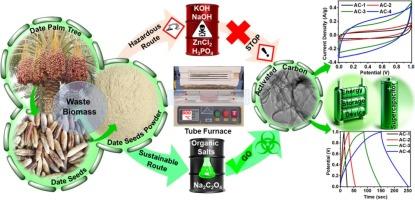Green synthesis of activated carbon from biomass waste of date palm seeds: A sustainable solution for energy storage and environmental impact
IF 8.9
2区 工程技术
Q1 ENERGY & FUELS
引用次数: 0
Abstract
Pursuing green, sustainable, and efficient energy storage devices has accelerated the development of techno-economically viable and environmentally benign activated carbons (ACs) derived from natural waste resources. Traditionally, chemical activation has been the favored approach to produce highly porous carbons; however, the environmental hazards posed by conventional chemical activators have shifted towards more sustainable and less corrosive alternatives. This study presents a novel synthesis of high-performance porous AC from waste biomass of date palm seeds, employing sodium oxalate (Na2C2O4) as a greener organic activating agent. This innovative method utilizes agricultural waste effectively and mitigates the environmental concerns associated with traditional chemical activators. The resultant AC, labeled AC-4, demonstrates outstanding electrochemical properties, boasting a specific surface area of up to 1630 m2/g. When evaluated in a symmetric supercapacitor (SC) configuration, AC-4 exhibited a specific capacitance of 112 F/g at a current density of 0.5 A/g and achieved a significant energy density of 16 Wh/kg at a power density of 250 W/kg. Moreover, the AC-4-based symmetric SC showcased exceptional durability and stability, retaining approximately 97 % of its capacitance and a Coulombic efficiency of around 94 % over 10,000 charge-discharge cycles, highlighting its robustness and suitability for next-generation energy storage applications. A preliminary life cycle assessment was conducted to analyze the environmental impact across the entire life cycle of AC-4, from resource extraction to end-of-life disposal. The findings confirm a reduced ecological footprint, underscoring the potential of Na2C2O4-ACs to advance sustainable energy storage technologies. Integrating this sustainable AC into SC technology aligns with eco-friendly manufacturing practices and sets a new benchmark for high-performance energy storage devices produced from waste materials.

从枣椰树种子生物质废料中绿色合成活性炭:一种可持续的能源储存和环境影响解决方案
追求绿色、可持续和高效的储能装置加速了从自然废物资源中提取的技术经济可行且环境友好的活性炭(ACs)的发展。传统上,化学活化一直是生产高多孔碳的首选方法;然而,传统化学活化剂造成的环境危害已经转向更可持续和更少腐蚀性的替代品。本研究采用草酸钠(Na2C2O4)作为绿色有机活化剂,利用废枣椰籽生物质合成高性能多孔活性炭。这种创新的方法有效地利用了农业废弃物,减轻了与传统化学活化剂相关的环境问题。所得的AC被标记为AC-4,具有优异的电化学性能,具有高达1630 m2/g的比表面积。当在对称超级电容器(SC)配置下进行评估时,AC-4在0.5 a /g电流密度下表现出112 F/g的比电容,在250 W/kg功率密度下实现了16 Wh/kg的显著能量密度。此外,基于ac -4的对称SC表现出卓越的耐用性和稳定性,在10,000次充放电循环中保持约97%的电容和约94%的库仑效率,突出了其稳健性和下一代储能应用的适用性。进行了初步的生命周期评估,分析了AC-4从资源开采到报废处置的整个生命周期的环境影响。研究结果证实了生态足迹的减少,强调了Na2C2O4-ACs在推进可持续能源存储技术方面的潜力。将这种可持续的AC集成到SC技术中,符合环保制造实践,并为利用废物生产的高性能储能设备树立了新的基准。
本文章由计算机程序翻译,如有差异,请以英文原文为准。
求助全文
约1分钟内获得全文
求助全文
来源期刊

Journal of energy storage
Energy-Renewable Energy, Sustainability and the Environment
CiteScore
11.80
自引率
24.50%
发文量
2262
审稿时长
69 days
期刊介绍:
Journal of energy storage focusses on all aspects of energy storage, in particular systems integration, electric grid integration, modelling and analysis, novel energy storage technologies, sizing and management strategies, business models for operation of storage systems and energy storage developments worldwide.
 求助内容:
求助内容: 应助结果提醒方式:
应助结果提醒方式:


